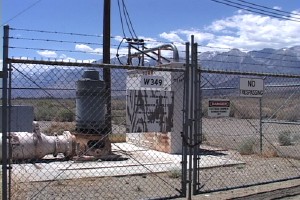By Deb Murphy
“No new wells” advocates took their message to Thursday afternoon’s meeting of the Los Angeles Department of Water and Power/Inyo County Technical Group, laying the groundwork for a revised environmental analysis of two new wells in the Bishop area and one in Bell Canyon west of Big Pine.
The Bishop wells, B-2 near the Gun Club north of Bishop and B-5 south of Schober Lane, were identified as potential sites in the Long Term Water Agreement and included in the 1991 Environmental Impact Report. According to LADWP staff, the wells will be used for irrigation on the Bishop Cone, coming under the Hillside Decree that no more water will be pumped than is used in the Cone.
The Big Pine well, evaluated in 2002-03 according to Mark Bagley with the Sierra Club, will supply the Big Pine Ditch System.
All three are in pre-construction evaluation status with that evaluation coming in the next few weeks according to Aqueduct Manager Jim Yannotta. LADWP is currently looking at contractors to begin drilling.
A fourth well in Laws will replace an existing well with the same capacity pump.
While LADWP refers to previous evaluations and inclusion of the Bishop wells in the LTWA, Bagley and Phil Anaya of West Bishop encouraged new California Environmental Quality Act analysis due to current conditions.
Bagley started with the Bell Canyon well, acknowledging that two wells were planned for the Big Pine Ditch, but the first “didn’t produce as hoped.” The wells were not evaluated as part of the 1991 EIR, but were included in the CEQA for the Big Pine Ditch in the early 2000s.
His major targets were the Bishop wells. “Conditions in West Bishop have changed,” he said. “There were domestic well issues and more homes built…. The Sierra Club feels (these wells) need a new CEQA.”
Background: During the second year of the current four-year drought, South Lake and Lake Sabrina were drained to historically low levels with no water to supply West Bishop ditches and creeks through the winter of 2013-14.
Beginning in December 2013, the area experienced an epidemic of dry wells. Many of those wells were older, shallow wells, but had been producing effectively for years. The conclusion of the County Water Department: the creeks recharged the aquifers those wells tapped into.
Anaya read a letter into the record, citing chapter and verse of the LTWA. “New wells will be sited and ground water shall be managed to avoid causing significant adverse effects on water quality and water levels in non-department owned wells in the Owens Valley that are attributable to ground water pumping by the Department.”
The LTWA also includes procedures for disputes arising from adverse effects of ground water pumping. According to Water Department Director Bob Harrington, the Technical Group is responsible for “analyzing the unique conditions at each (well) site to evaluate its compatibility with the LTWA’s goal of avoiding adverse impacts.”
If the issues can’t be resolved by the Technical Group, the matter goes to dispute resolution.
But, perhaps, the quickest way to avoid the pumping/adverse effects/dispute/mitigation cycle would be legal action brought by a third party requiring new CEQA analysis.


















No wells for LA, surface water only! =
Their going to continue to steal as much water as they can get their greedy hands on . Nothing will change.
But, I’m glad someone is trying to slow them down.